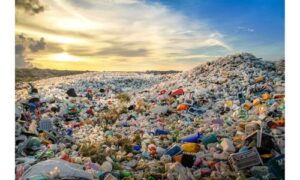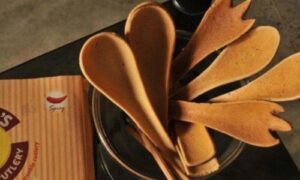INTRODUCTION
- Plastic cutlery is a practical option, but also bad for health and the environment. Being a petroleum by-product, it contains carcinogens and poisons that are easily absorbed by humans. Because plastics take up a lot of space and clog landfills yearly, throwing away plastic cutlery is now dangerous for the environment because chemicals and carcinogens can leach into food through the natural ecosystem.
- Even though plastics are widely used in our daily activities, it is imperative that we make efforts to replace plastics in our lifestyle to effectively reduce their usage and help create a cleaner, greener, and more sustainable environment [1].

Figure 1: Plastic cutlery contributes to a humongous amount of non-biodegradable waste [1].
Edible Cutlery
- Edible cutlery was designed to address the problem of plastics being used in disposable cutlery. In addition, it is organic, biodegradable and compostable and may be developed to be nutrient-rich.
- Edible cutlery, a plant-based product, can be used to serve meals and consumed as it is. Since the product is composed of various flours, it is typically considered EBO (eco-friendly, biodegradable, and organic). A company in India named Bakey’s has been selling commercial edible cutlery since 2010 [2].

Figure 2: Edible cutlery produced by Bakey’s [3]
Preparation of Cutlery
 Figure 3: A schematic diagram of the preparation of edible cutlery [2].
Figure 3: A schematic diagram of the preparation of edible cutlery [2].
 Figure 4: Salient features of edible cutlery [1]
Figure 4: Salient features of edible cutlery [1]
Since edible cutlery is still relatively new to the market and most consumers do not use it frequently, consumers continue to be concerned about its use. Even while the edible cutlery that is now available may be used to eat any form of food, including hot soups, bhelpuris, salads, and ice cream, it does not wear out quickly. They also think it is a matter of time until durability concerns fade [1].
Market for Edible Cutlery

Figure 5: There has been a steady rise in the market for edible cutlery [4]
From a sustainable perspective, edible cutlery significantly reduces packaging material waste. Additionally, producers of edible cutlery can use materials like wheat bran, rice bran, sorghum, corn, etc., to seize this chance to enter the edible cutlery industry. In 2022, the global market for edible cutlery was worth USD 37,850 million. The Compound Annual Growth Rate (CAGR) is estimated to be 11.1%, and by the end of 2032, this market is projected to increase and reach up to USD 108, 444.24 million [5].






